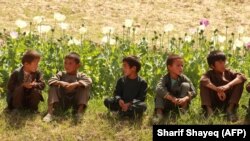Opium production in Afghanistan dropped by 29 percent last year, the United Nations anti-drug agency reported, a decrease attributed mainly to a severe drought.
The United Nations Office for Drugs and Crime said in its annual report released November 19 that the drop—from 9,000 tons to 6,400 tons—coincided with a decrease in the amount of land area being used for cultivated the crop.
The Afghanistan Opium Survey, which is jointly compiled by the U.N. agency and the Afghan Ministry of Counternarcotics, said a total of 263,000 hectares of land was used for opium cultivation, representing a decline of 20 percent compared to 2017.
"Despite the decreases, the overall area under opium poppy cultivation is the second highest ever recorded. This is a clear challenge to security and safety for the region and beyond,” said UNODC Executive Director Yury Fedotov.
The report said the farm-gate prices of dry opium -- which fell for the second consecutive year to an average of $ 94 per kilograms, the lowest level since 2004 -- may have contributed to less cultivation of opium poppy.
Eradication of opium poppy has also dropped by 46 percent in 2018 to 406 hectares, compared to 750 hectares last year.
Ten of Afghanistan's 34 provinces are considered poppy free, unchanged from last year.
Afghanistan is the world’s largest producer of opium and international donors have spent billions of dollars on counternarcotics efforts in the country over the past decade, including efforts to encourage farmers to switch to other crops.





